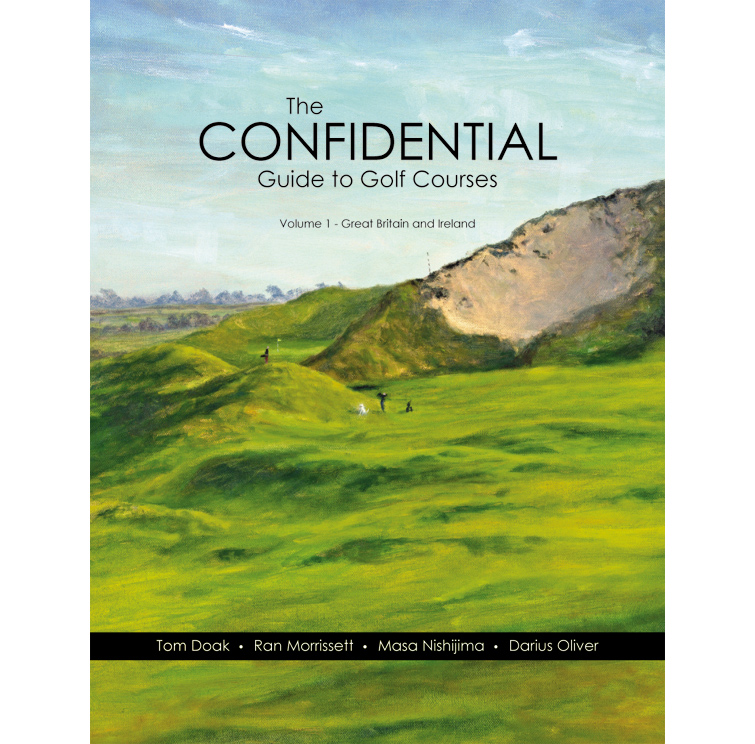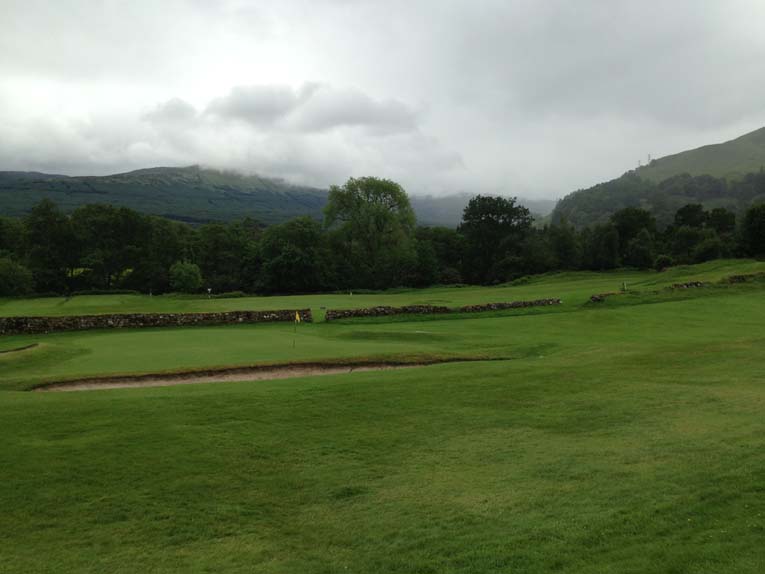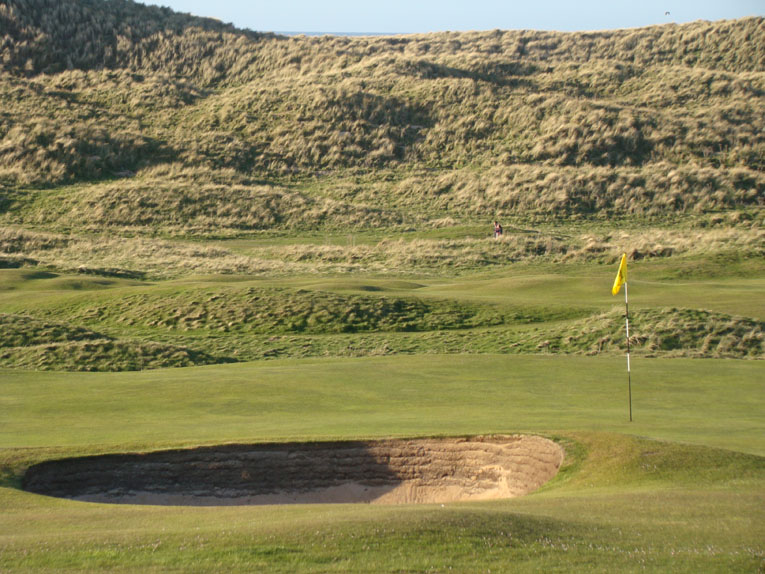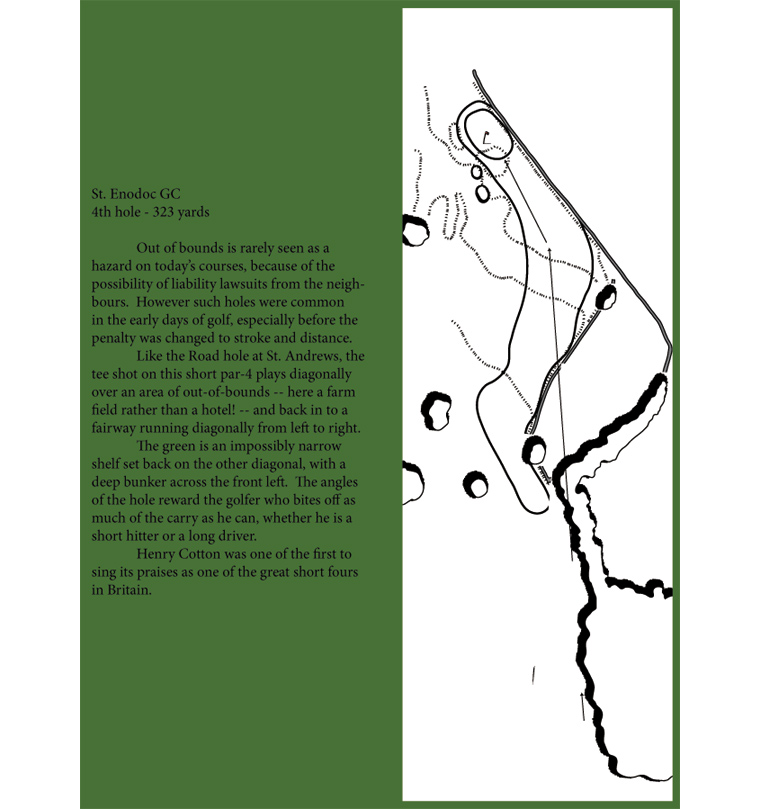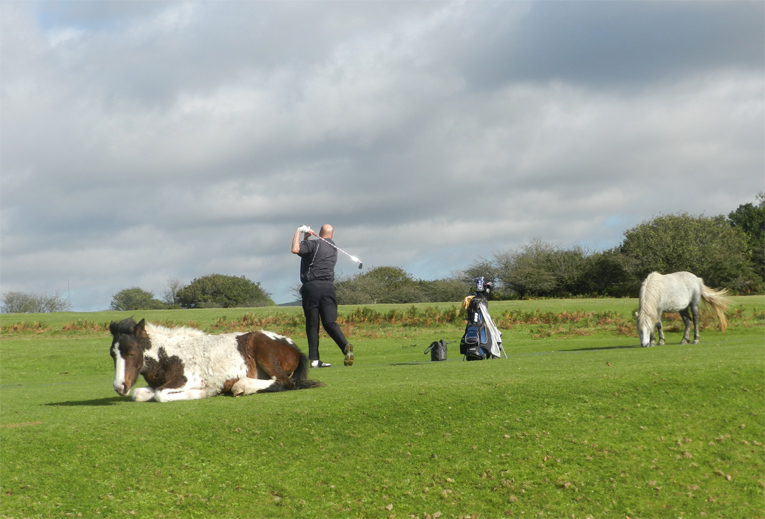Feature Interview No. 4
with
Tom Doak
September, 2014
Tell us the history of The Confidential Guide. Didn’t Norm Klaparda show me a loose leaf binder from the early 1990s that preceded the infamous maroon leather version?
The original book was printed and given to 40 friends as a Christmas gift in 1988. There were 20 more in 1989 … Norman has a copy of that second printing, I believe. It was written as a thank-you to people for helping me to get around and see all these courses, so they wouldn’t need to call me and ask which courses they should see in England or Scotland. Since it was strictly for friends, there was zero self-censorship of reviews.
George Peper, the editor of GOLF Magazine, was one of the first recipients, and he wrote about the book in his column in the September, 1989 issue. After that, I started getting requests for it … and notes from people who had “seen pages” or had pirate copies! There were some inquires from publishers, which led to my second book, The Anatomy of a Golf Course. But I still wasn’t sure I wanted to publish The Confidential Guide for a general audience. It was too personal, and I knew it would be controversial.
I changed my mind in 1994. Business was slow — I paid my associates more that year than I paid myself — and I knew the book had value. Also, a couple of friends [including Ron Whitten] convinced me that most of the people who would be offended by the book were ALREADY offended, so I had nothing to lose and a lot to gain by putting it out there — having seen all those courses was really my main credential for being a golf course architect. So, I decided to print 1000 books and sell them myself. I actually sold about 700 of them by word of mouth, without the benefit of the internet.
My friend Brian Lewis, who helped get the limited-edition book printed for me, convinced me to do the color version for Sleeping Bear Press a couple of years later. The attraction of that edition was being able to share all my photographs. There were 12,000 copies in that run, and it’s been out of print ever since.
I should note that the new edition is entirely new. The last version of the book was stored on old floppy disks, which my computer can’t read, so I had to retype the whole book, and I’ve rewritten most of it in the process.
What prompted you to update it?
The book is a big part of who I am. I love to go and see new courses, but I’ve been so busy with my design work that I needed to push myself to get out there and see others’ work again. It has been nice to get back out and see things just for the joy of it, and there is a lot of joy to be found in Great Britain & Ireland.
I’ve also gone back to it because there is still a market for the book. It’s been crazy to sit on the sidelines and watch people pay hundreds of dollars for the old book as it’s achieved collector status. The whole purpose of the book was to help people identify where they’d like to travel; that shouldn’t cost them an arm and a leg, and it shouldn’t enrich guys who hoard books and re-sell them. But it IS valuable information.
Walk us through the new Confidential Guide. It is actually a series of books?
There will be five volumes, which we plan to sell for $60 each. If you sign up for the set, the last book in the series will be half price. The five volumes will be:
1) Great Britain and Ireland
2) The Americas (winter destinations) – southern U.S., California, Caribbean, Mexico, Central and South America – generally, wherever they grow bermudagrass
3) The Americas (summer destinations) – northern U.S. and Canada
4) Europe, the Middle East and Africa
5) Asia and Australia / New Zealand
Volume one is the United Kingdom and Ireland. How many courses are covered in it? How many did you personally see?
Volume one is the smallest of the five, but there are 288 courses reviewed, which surely covers most of the courses you’d ever think about visiting in Britain and Ireland. There are 82 courses that weren’t reviewed in the previous edition. I’ve seen all but 21 of them myself, so, 267 courses. That means I’ve visited 95 additional courses since my original Cornell-funded trip in 1982-83.
Wow! So what GB&I courses remain that you would still like to see for the first time?
I have a list of ten on the last page of the book. They include such places as Mininchampton Old Course, Royal Guernsey, Castletown on the Isle of Man, and Temple Golf Club near London.
Once you knew the first volume was dedicated to the GB&I, how many trips did you make there?
I made three trips in 2013: to the north-west of Ireland in March; to the north of Scotland in June; and to the midlands and west of England in early October. My wife went with me for the last two, and we had a great time seeing some of the roads less traveled. I took her to St. Enodoc, which is one of my favorite places; a painting of the 6th hole at St. Enodoc is on the cover of the book. I’ve also just plugged into the book three small courses in the west of Scotland that we saw this June, on our way to Askernish.
Of those trips, which three courses made the greatest first time impressions?
The highest grades I handed out to courses I hadn’t seen before were 7’s, for Castle Stuart, Kington, and Trump International. I wonder what The Donald would think of Kington? Playing there with Sean Arble was a highlight.
But, some of my favorite places were courses I just stumbled upon. For example, I was driving from Carne to Connemara with my friend Dewey Ducharme, exhausted by all the big dunes at Enniscrone and Carne, when I pointed to a patch of gentle linksland and said “That’s the sort of property people should build golf courses on.” Two minutes later, we discovered it WAS a golf course; we saw a turn-off for Mulranny Golf Club, and detoured for a look. What a cool place; I hope that the damage they suffered over the winter can be fixed.
I had written at the start of the reviews section of the book that “more can be learned about the game of golf by stopping at a random Scottish course, whether it was laid out by a local punter or Old Tom Morris himself, than from most ‘Top 100’ tracks.” Well, this June I had occasion to test that theory with my wife, when a temporary road closure due to an accident caused us to cool our heels in the town of Killin. So, I went and walked the nine holes there; it’s a goat-hill layout, but the opening tee shot hits over a bend in the river, and the par-3 5th [94 yards!] has a stone wall right across the front of the green. Better yet, while reading a tourist sign at the Falls of Dochart, right in town, I discovered that Killin was the ancestral home of the MacNab clan — which includes my wife’s grandfather! And so we visited her clan’s burial ground, on an island in the river … all because of somebody’s traffic accident.
American golfers miss out when they stick to the familiar destinations on their overseas trip. The rankings of courses have made it worse, by inserting themselves as a litmus test of whether a course is worth seeing or not. [I wish I had a dollar for every time you tried to insert the phrase “belt-notching tourists” into the manuscript! … though that attitude bothers me just as much as it bothers you.] Hopefully, the book will prompt some people to check out a smaller course they wouldn’t otherwise have included in their plans.
Drill down on your upgrade of Royal Aberdeen from a 5 to a 7. What specifically caused that?
I’ve always known there were some courses that got short-changed years ago, just because of a poor personal experience. When I visited Royal Aberdeen in August of 1982, it was on an awful, rainy day. I’d spent the previous month and a half caddying on The Old Course, and was heading back there after a few days in Dornoch. I’d just fallen in love with Cruden Bay the day before. In that context, Royal Aberdeen seemed pretty dreary.
I went back last summer, and walked the course the evening before I played the new Trump course. The front nine is terrific; I remembered great holes like the 3rd and the 8th, but not all the fine holes in between. The back nine still doesn’t resonate with me, so I don’t rate the course as highly as you and Darius do; but it does set a high bar for Trump International to clear if it wants to be the best course in Aberdeen.
Let’s discuss the opposite from your Royal Aberdeen experience. That is, you have a purple patch first visit: bright blue skies, shadows, birds chirping, 18 mph wind, empty course and to top it off, you play well, perhaps in front of a wonderful host. How disciplined are you in evaluating the course only and not all the extraneous stuff present (good or bad) that one day?
Golf course architecture is my #1 interest, so it’s not hard to place that in context when evaluating a course. If the course isn’t interesting, it doesn’t matter how well I play, it’s not going to get a good rating. Now, if the course IS interesting, there might be a temptation to rate it a point higher if I’ve played well and really enjoyed it, but I’m usually pretty guarded about that: in fact, it took me a third trip back to St.Enodoc to bump it up to an 8, because I didn’t want to let my magical first round there cause me to overrate it.
Did you see a twist on a design feature that you are keen to employ on a future design?
You never know when something will trigger an idea. I saw the 3rd hole at Woking in 1982, and eighteen years later it occurred to me that a similar approach shot would be perfect on the 8th hole at Pacific Dunes. The key is to remember a feature that fits the situation. But, I don’t keep a notebook of ideas to “borrow”.
Your writing versus the mere assignment of a numeric grade is what made prior editions so popular. Surely it was easier to be somewhat acerbic when you were just getting going in the business than now. Should people expect more tempered comments from the 53-year-old Doak than the 27-year-old Doak?
In that very first edition, I was only writing for friends, and I didn’t imagine that my comments would be taken so seriously by others. Today, I’m better known, and anything I say has more weight to it, so I do have to think twice sometimes.
However, it’s the spirit of the original edition that made the book what it is, and I was only going to revisit it if I stayed true to that spirit. That’s another reason I took on some co-authors, to hold me to that pledge. Most of our reviews are quite short, so they get right to the point. If I dislike a course, there is no pussy-footing around it.
Some people will read Volume 1 and think I’ve mellowed, just remember we are talking about the golf courses of Great Britain & Ireland, and there aren’t a lot of zeroes over there. [Actually, there is one, and I’m sure I’ll be questioned for saying so because of who designed it.]
When we get back to American courses, you’ll see that I still have the ability to be very critical.
Despite my begging, you stuck with your policy of only assigning whole grades as opposed to allowing +/- to further refine the grading process. Some courses neatly fit into a grade while others are on the fence. How do you decide when to nudge one up or down?
When in doubt, I just go back to my list of the courses which received 5’s and 6’s and 7’s, and see which group a course seems to fit in with most comfortably … but I tried to avoid making revisions to my ratings unless I had seen the course again.
Really, the beauty of having multiple grades on courses is that it reveals whether a course is a 6 leaning toward 7, or a 6 leaning toward 5. The toughest ratings are when we’re all alone in rating the course, and there is more riding on what we say. Welcome to the big leagues!
What factors go into your own personal assessment of a course?
I wrote a whole page on that in the introduction, so that people who aren’t familiar with us will understand where we’re coming from.
The one factor that means a lot more to me than to most reviewers is originality. I’m not so impressed by a course that offers just straightforward, solid golf … you don’t have to travel far from home to find that. But if a course has one terrific hole that isn’t quite like anything I’ve seen before, I probably overrate that course, relative to some other reviewers. I’m looking for something special.
What role, if any, does difficulty in terms of testing the championship golfer play in your evaluation? Could a course be a Doak 9 or 10 and not require the use of the driver?
To get to the upper reaches of the Doak scale, a course has to provide challenging shots for a low handicapper … but I’m only thinking about a single-digit player, not a Tour player. [Tour players are generally not who I’m writing for, or building my courses for.] The highest-rated course that isn’t particularly hard is North Berwick, which has gone up to a 9 on the Doak scale now; a Tour player would not have any trouble breaking par at North Berwick, but he’s going to be tested here and there along the way, and he’s going to have fun there.
I don’t know how often you pay to play a particular course but cost is an important consideration for many. Should value be considered?
I will sometimes mention in the reviews if I think a course is a great value, but it’s impossible to really make it a factor in my evaluations, because the equation is so different for different readers — Julian Robertson doesn’t care what Sean Arble’s definition of “too expensive” is. The bottom line is that whatever the green fee, a reader is going to spend a bunch of money and time traveling to see a course we recommend; if the course is worth that effort, then the green fee shouldn’t keep him away. But ultimately it is for every reader to decide on their own.
What if a course has a real stinker of a hole? How much does that bother you, especially if you as an architect see a ready solution? For instance, I don’t give Dornoch a perfect 10 with its sixteenth hole.
I hardly ever try to redesign a hole on a course I have nothing to do with; I just take them as they come. The longer I’ve been around, the less I mind a course having an awkward hole or two, if we are talking about an older course where they didn’t move earth around to build it. Lots of times, those holes provide a real mental challenge to golfers.
Does playing help you evaluate a course? Or are you more content to walk the holes with no playing concerns?
It can go either way. Sometimes you find out something from playing the hole that you wouldn’t have noticed otherwise; other times, you play yourself out of a hole and fail to notice important details. So I’m perfectly happy to evaluate a course just from walking around it. If I can imagine how my own courses are going to play while they’re still in the dirt, I ought to be able to visualize play on a completed course.
There are more sub 6,000 yard courses in this volume than will be in the next four volumes combined. Why is it that the UK understands how to have fun with the game of golf while most other countries continually struggle by making the game too long and difficult?
That’s a great question!
I suppose the main reason UK clubs are fine with shorter courses is that as member-owned clubs they are only interested in doing what makes sense for themselves; they aren’t trying to market their courses to outsiders. Contrast that with America [or Asia], where every facet of new courses is influenced by marketing, and bigger is assumed to be better. Most of the better short courses you find are just out of room; if they could lengthen them, they would feel obliged to. Golf course owners and club members cannot even see that there is a choice in the matter.
As we’ve noted in the book, quite a few courses in Ireland have recently made their courses longer and more difficult, to try to attract Americans to pay higher green fees to subsidize the locals, but in many cases it seems to be backfiring. As my friend at Portnoo said, all they’ve really done is make the course take 45 minutes longer to play. The Scots and the English have little interest in that.

Fun golf comes in all sorts of shapes and sizes, including the nine hole Traigh in the Northwest Highlands of Scotland.
Any negative trends in the GB&I that give you pause for concern?
It’s obvious that a lot of the top-tier courses [and quite a few in the second tier] are trying to cater to what they think American tourists want, or to what they think will land them a top-100 ranking, or a spot on the Open rota. Portrush is impossibly narrow now, with the thickest rough I’ve ever hacked out of. Cruden Bay is just barely in the top 100, and concerned they will fall out because it’s too short or too easy, so they are considering changes to beef it up. Most of the tourist courses are greener than they used to be, partly to handle the traffic from overseas visitors, but also partly to appeal to their esthetic values.
The biggest cause for concern is that even in Scotland and England, the smaller clubs are struggling to survive, as people find less time to play golf. If it’s happening there, we aren’t going to stop it here. We’d just better get used to the idea that we don’t need more golf courses, and concentrate on making the most of the ones we have.
You asked Masa Nishijima in Japan, Darius Oliver in Australia and myself in Southern Pines, North Carolina to assist. Why?
I wanted the book to be as complete as possible, and thought of people who could help fill the gaps in my own travels. But, it was equally important to choose collaborators who had similar tastes; otherwise the book would be a meaningless internal debate. I trusted the three of you to apply the Doak scale as I would.
Of all the courses that the four people had played, who passed out the stingiest grades on average? Who gave the highest marks? What was the difference between the two averages?
There are 222 courses [around the world, not just in this first edition] that we all four have played. My average score for those courses is 7.12. You are the “softie” of the group, with an average of 7.30; Darius’ is the lowest at 6.77. [Darius started by only awarding seven grades of 10.] However, those are courses where I had already set a benchmark grade. When I look at the scores on courses I haven’t played, there is a wider range … your scores are generally high, Darius’ scores are generally low [but not very low], and Masa’s are all over the board.
Tell us about the additional features and illustrations found in this book that weren’t present in previous editions.
For starters, in each section there are maps to help locate the courses relative to one another. They aren’t super-detailed, that’s what GPS is for, but they do help you see what neighboring courses you might want to check out while you’re in an area, and that is one of my biggest goals for the book, to draw attention to lesser-known courses. Second, I’ve done some diagrams of great golf holes, interspersed throughout the reviews section, at the suggestion of my former associate Kyle Franz. He pointed out that many readers aren’t familiar with what makes a golf hole great, and just a few diagrams go a long way to helping them understand. My European associate, Angela Moser, prepared all the diagrams and maps in the book. Third, by popular demand, there is an appendix in the back of the book that lists the courses in order of their ratings on the Doak scale. This is NOT meant to be a ranking, just a quick way to compare potential destinations, or suggest a new one.
Volume 2 – what’s its subject matter and when will it be released?
My intention is to produce a new volume every 12 months. We could probably do it faster, but the whole intent is to take time to see some courses that we [or I] haven’t covered yet.
Volume 2 will cover half the Americas. Instead of the usual east/west, I’ve decided to divide it north and south. This volume will cover the south — the courses you’d go to see in the winter months. Before we put it into production next summer, I hope to do a tour of South America with Randy Thompson, to see some courses in central America with Mike Young, and to see the courses in Mississippi and Louisiana that Tiger Bernhardt recommended to me before he passed away. And perhaps this winter I’ll convince my wife to check out a couple of Caribbean golf resorts — that ought to eat up most of my share of the profits from Volume 1!
There is a lot of mediocre (!) golf in the regions to which you will be traveling. Unlike most list collectors I know, you are willing, sometimes even keen, to head to what will amount to a Doak 4 or 5 course. When are such visits worthwhile? When are they a dud?
It is all about seeing something different or well done — whether it’s a single golf hole, a unique feature, the routing, a new architect’s work, whatever. I’m just hoping it is not all straightforward.
What type of golfer/traveler would benefit the most from The Confidential Guide? Is there a type that might be disappointed?
Above all, the book is for people who love to travel and to see something different. The more you travel, the more you’ll enjoy it, because at some point you’ll get past trying to play the top 100 and at that point you are going to start looking for the kinds of courses that appeal to the four of us. I suppose there are some people for whom tough-but-fair design and immaculate conditioning are the main attraction, and that is certainly not our worldview, but even for them I think our reviews will be helpful in sorting out where they want to go and not go. You don’t have to agree with our viewpoint in order to use the book.
The End


